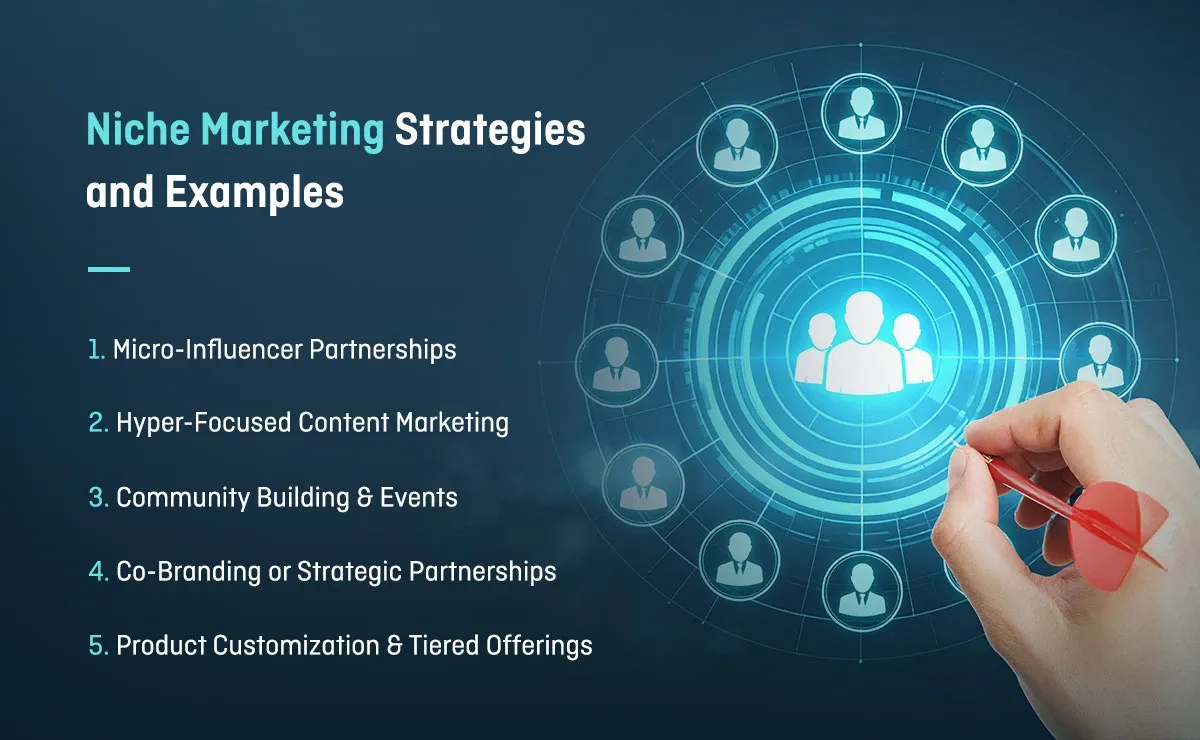What is Niche Marketing?

Niche marketing is a highly targeted marketing approach that enables businesses to focus their efforts and resources on reaching a specific, well-defined subset of consumers whose needs, preferences, and pain points differ from the broader market.
As digital platforms become more fragmented, it’s becoming difficult for brands to cut through the noise by appealing to everyone. Instead, companies need to round in on distinct niches or groups of consumers with unique characteristics to build authentic connections, optimize ad spend, and cultivate brand loyalty.
This article explains the importance of niche marketing, understands its advantages and disadvantages, and explores real-world niche marketing strategies and examples.
Defining Niche Marketing
Niche marketing is the art and science of identifying a narrowly defined segment of potential customers—each with distinct needs, preferences, or demographic traits—and tailoring your product, service, and messaging to that group. Instead of targeting a broad, general audience, niche marketing zeroes in on a compact, well-defined segment. This approach typically involves:
- Precise Audience Definition: Segmenting the market by factors such as age, gender, income, lifestyle, geography, values, or even specialized use cases (e.g., “diaper-bag handbags for new, working mothers”).
- Customized Offerings: Designing products or services that solve the unique pain points of that niche (e.g., a cruelty-free deodorant formulated for darker skin tones that leaves no white cast).
- Tailored Communication: Crafting messaging, visuals, and channels that resonate specifically with those customers, rather than relying on generic, broad-based advertising.
By concentrating on a well-defined group, niche marketers can differentiate themselves, foster deeper brand loyalty, and optimize marketing spend—ultimately achieving higher returns on investment compared to mass-market campaigns.
Why is Niche Marketing Important?
In the digital age, several factors converge to make niche marketing not only valuable but necessary for sustainable growth:

Digital Overload and Consumer Expectations
In today’s saturated media environment, consumers are bombarded with thousands of messages every day. Whether scrolling through social feeds or searching eCommerce platforms, they increasingly tune out generic advertising that tries to speak to “everyone.” Instead, prospects respond best when they feel that a brand truly “gets” their unique circumstances.
For brands, this means recognizing that broad-based messaging often yields low engagement rates, whereas niche-targeted campaigns can achieve significantly higher relevance, click-through rates, and overall impact.
Precision Targeting Reduces Waste
Traditional mass-market strategies allocate large budgets across broad demographics. In contrast, niche marketing allocates resources only where they’ll have the greatest effect, which is among people most likely to purchase. Platforms like Facebook, Instagram, LinkedIn, and Google Ads now offer granular targeting filters based on interests, behaviors, job titles, seniority, life events, etc. This helps marketers zero in on tiny subgroups.
For example, if you’re selling cruelty-free deodorant formulated for darker skin tones, you can specifically target “socially conscious consumers” and “beauty enthusiasts of color,” rather than running a generic deodorant ad to a mass audience.
Building Stronger Brand Loyalty
When a brand addresses a very specific pain point, it fosters a sense of belonging among its customers. These consumers feel seen, understood, and valued. As a result, they become vocal brand advocates, recommending the product to friends, creating user-generated content, and driving organic word-of-mouth growth.
Brands implementing relationship marketing and observing how niche brands cultivate tight-knit online communities (e.g., Facebook Groups, Reddit threads, Discord servers) offer a blueprint for building long-term customer loyalty and reducing churn.
Lower Competitive Intensity
In mature, mass-market categories such as general skincare, athletic apparel, or smartphones, competition is fierce. Large incumbents with massive budgets dominate. By contrast, niche segments often have fewer direct competitors.
For instance, while there are dozens of laptop manufacturers, very few produce ergonomic keyboards designed specifically for programmers with small hands who face repetitive strain issues. Such a company can quickly establish market share by addressing this overlooked need. Companies examining Porter’s Five Forces will note that niche marketers often face lower rivalry and can create a defensible competitive advantage.
Opportunities for Thought Leadership and Innovation
Niche brands frequently become recognized authorities within their micro-communities. By publishing in-depth content like how-to guides, case studies, best-practice webinars, etc., they demonstrate expertise that resonates with their focused audience. Additionally, because they’re closely connected to a small group of highly engaged customers, they receive rapid feedback loops, enabling faster product iteration.
For instance, a company known for reusable, plant-based food wrap engaged directly with zero-waste and plastic-free communities on forums and social channels to refine material blends and packaging designs. This demonstrates how being narrowly focused can accelerate innovation cycles and thought-leadership positioning.
Steps to Develop a Niche Marketing Strategy?
Developing a niche marketing strategy involves a structured process that begins with deep research and ends with ongoing measurement and iteration. Below is a step-by-step framework that students can apply to any hypothetical or real brand scenario.
Step 1: Conduct Deep Market Research
- Market Segmentation: Divide the larger market into precise groups using demographics (age, gender, earnings), psychographics (beliefs, hobbies, way of life), location, or product usage scenarios.
- Data Gathering: Use keyword tools, industry reports, and social listening to quantify demand and uncover discussions around pain points.
- Primary Feedback: Run quick surveys or informal interviews with potential customers to validate whether the identified segment truly represents an under-served group.
Step 2: Define and Validate the Niche
- Size & Viability Assessment: Estimate Total Addressable Market (TAM), then narrow to Serviceable Addressable Market (SAM) and Serviceable Obtainable Market (SOM). Confirm that the segment is large enough to sustain your business objectives.
- Profitability Check: Calculate approximate margins by comparing expected production and delivery costs against price points the niche is willing to pay.
- Minimum Viable Offering (MVO): Create a simplified version of your product or service—enough to address the core need—and test it with a small group. Evaluate key metrics (e.g., conversion rates, feedback scores) to decide whether to proceed.
Step 3: Craft a Precise Unique Value Proposition (UVP)
- Audience Definition: Clearly specify “who” you serve (e.g., “home bakers seeking gluten-free bread mixes”).
- Problem Statement: Articulate the specific challenge the niche faces (e.g., “difficulty finding consistent gluten-free textures”).
- Core Benefit: Distill how your offering solves that problem in a way competitors do not.
- Evidence/Proof Point: Include concise validations, like data, testimonials, or certifications, that build credibility.
Step 4: Analyze the Competitive Landscape
- Direct Competitors: List brands already targeting the same niche; note their strengths, weaknesses, pricing, and positioning.
- Indirect/Substitute Offerings: Identify products or services that partially satisfy the need (e.g., if your niche is vegan cheese, a substitute could be general dairy or lactose-free options).
- Gap Mapping: Pinpoint unmet needs or recurring customer complaints in competitor reviews. These gaps become areas where your brand can differentiate.
Step 5: Develop Messaging, Branding, and Positioning
- Voice & Tone: Tailor your content, images, and tone to reflect the niche’s preferences.
- Brand Identity Elements: Ensure colors, design, and visuals resonate with that specific community.
- Key Messages & Objection Handling: Craft core talking points that highlight your UVP and preempt common objections.
Step 6: Plan and Execute a Pilot Campaign
- Budget Allocation: Start with a modest budget, assigning funds to your top two or three channels. For example, a small PPC test on Google paired with a targeted Facebook ad.
- Creative Variations: Produce at least two versions of ad copy or landing pages to A/B test headlines and calls to action.
- Tracking Infrastructure: Set up analytics (Google Analytics, UTM parameters, or platform-specific tracking) to measure clicks, conversions, and cost per acquisition (CPA).
Each phase ensures you remain focused on providing the precise value that your defined audience seeks, rather than diluting your resources across a broad, less-responsive market.
Advantages and Disadvantages of Niche Marketing
Niche marketing offers a compelling set of advantages, but there are also certain disadvantages that brands should consider.
Advantages | Disadvantages |
Lower Competition: Fewer direct competitors in a narrowly defined segment, allowing for clearer differentiation and premium pricing. | Limited Market Size: By definition, niches are smaller, which can cap revenue potential and slow overall growth. |
Enhanced Brand Loyalty: By meticulously catering to unique demands, businesses build deeper emotional bonds, driving repeat sales and word-of-mouth promotion. | Vulnerability to Trends: Niches tied to fads (short period trends) or shifting consumer preferences can shrink quickly if demand wanes. |
Efficient Marketing Spend: Targeted campaigns using precise demographic and interest filters yield higher conversion rates and lower CAC. | Higher Per-Unit Costs: Smaller production runs or specialized products often increase manufacturing and fulfillment costs. |
Thought Leadership & Expertise: By focusing on a micro-community, brands can publish in-depth content (guides, webinars) and become authoritative. | Dependence on Specific Channels: Overreliance on one platform or influencer can backfire if that channel’s algorithm or credibility changes. |
Faster Innovation Cycles: Close feedback loops with engaged customers help enable rapid product iteration and improvement. | Risk of Brand Dilution: Expanding too quickly into adjacent segments can confuse the core audience and dilute brand identity. |
By anticipating these benefits and challenges, brands can build guardrails into their strategy, such as regular business reviews, scenario planning, and conservative financial projections, so that setbacks remain manageable.
Niche Marketing Strategies and Examples

Micro-Influencer Partnerships
Identify and collaborate with influencers who have small-to-mid-sized followings (10K–100K) within your niche. Micro-influencers often achieve better interaction levels and stronger credibility within their niche follower base. Instead of paying for one celebrity endorsement, you work with multiple niche experts who speak directly to tightly defined segments.
Example: A maker of organic, gluten-free dog treats sends samples to 5–10 influencers (20K–50K followers) who post “taste test” Reels, driving high engagement from dog owners seeking allergy-friendly snacks.
Hyper-Focused Content Marketing
Create deeply specialized, SEO-optimized content like blog posts, guides, or videos that address very specific questions or pain points of your niche. Optimize each post around long-tail keywords so when your audience Googles solutions, these guides consistently rank high and drive organic traffic.
Example: An ergonomic desk company publishes a single blog post titled “Designing a Home Office for Graphic Designers in 200 sq ft Apartments,” ranking for “small-space ergonomic desk” searches and attracting precisely that audience.
Community Building & Events
Develop an online or offline community through a forum, Facebook group, Discord server, or recurring meetup where members of your niche can gather, share insights, and solve problems together. Hosting webinars, workshops, or local gatherings cements your brand’s position as a central hub and thought leader.
Example: A gender-inclusive activewear brand hosts monthly “All-Bodies Yoga Night” meetups and maintains a fitness Facebook group, fostering loyalty and driving repeat purchases from participants.
Co-Branding or Strategic Partnerships
Form alliances with complementary niche businesses to cross-promote or co-create offerings. This reaches customers who already trust one partner, exposing your brand to a highly relevant micro-audience.
Example: A vegan meal-kit service teams up with a plant-based protein powder maker to create a “Post-Workout Recovery Box,” cross-promoted via each brand’s email list and social channels, reaching shared health-conscious customers.
Product Customization & Tiered Offerings
Offer a base product that can be customized or tiered to address small sub-segments within your niche. This lets you capture adjacent micro-niches without diluting your core brand identity.
Example: An ergonomic gaming mouse manufacturer introduces two variants—“Speed“ Runner Edition” (ultra-lightweight) and “Endurance Pro Edition” (cushioned grip for gamers with hand strain)—marketed in niche Discord channels.
FAQ’s
Q1. What is a niche in affiliate marketing?
Ans: In affiliate marketing, a niche is a narrowly defined segment of consumers with shared interests or needs that an affiliate targets with tailored content. Instead of promoting a broad range of products, the affiliate focuses on a specific topic—such as “organic skincare routines for sensitive skin” or “budget DSLR cameras for wildlife photography.
This approach attracts highly qualified visitors, leading to higher conversion rates and commissions due to better alignment with user search intent.
Q2. What is a niche in digital marketing?
Ans: A digital marketing niche is a precisely defined segment of the market that a brand targets with customized messaging and offers. Instead of a broad approach, it focuses on a specific demographic or interest group, using precise targeting tools to reach the most relevant audience. This strategy leads to higher relevance, lower acquisition costs, and stronger customer loyalty.
Summing Up
Niche marketing lets brands connect deeply with a narrowly defined audience by tailoring products, messaging, and channels to specific needs. Through focused research, a clear unique value proposition, and precise targeting, businesses can gain higher relevance, lower competition, and stronger customer loyalty.
Although niche segments may be smaller and subject to rapid trend shifts, disciplined validation and ongoing iteration minimize risk. In today’s fragmented digital landscape, prioritizing precision over mass appeal ensures more efficient ad spend, faster innovation, and a sustainable competitive advantage.





